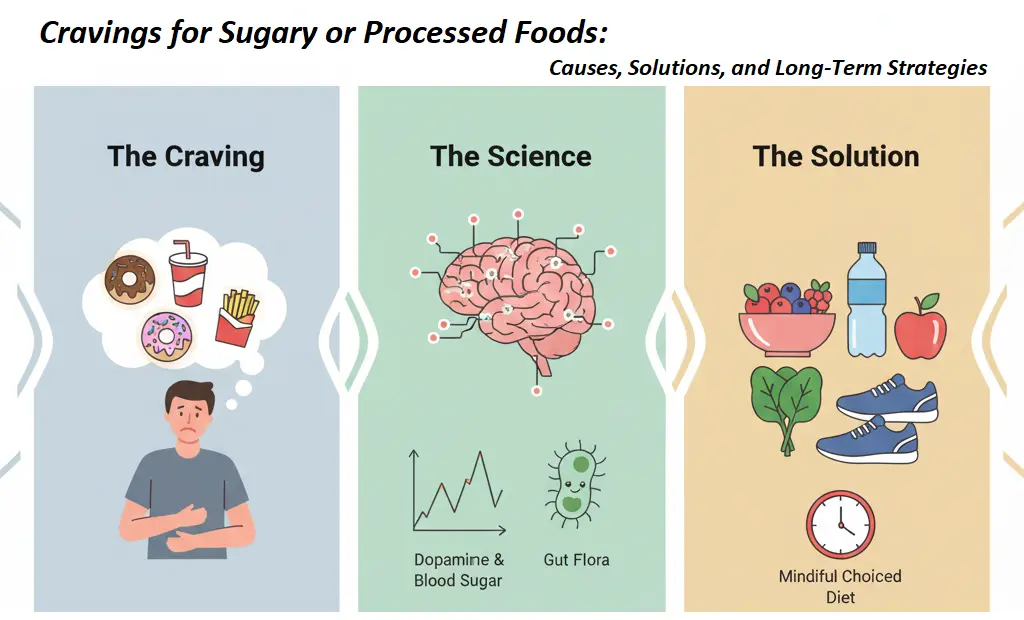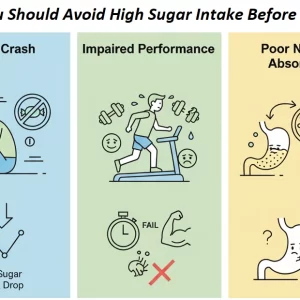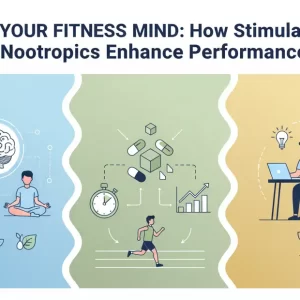Contents
If you’ve ever felt an uncontrollable urge to grab a chocolate bar, finish a bag of chips, or binge on fast food, you are not alone. Cravings for sugary and processed foods are among the most common nutrition challenges faced today. Despite knowing these foods often lack nutrients and contribute to health problems, resisting them can feel almost impossible.
Cravings are not simply a matter of “weak willpower.” They are the result of complex interactions between your brain, hormones, gut, and environment. By understanding these underlying mechanisms, you can take back control and develop long-term strategies that support your fitness, health, and overall well-being.
This article explores why we crave sugary and processed foods, the health consequences of giving in too often, and practical strategies to reduce cravings without feeling deprived.
Why Do We Crave Sugary and Processed Foods?
Cravings are not random—they are rooted in biology and psychology. Here are the most common drivers:
1. Blood Sugar Swings
Sugary and refined foods are quickly broken down into glucose, causing a spike in blood sugar. In response, insulin is released to bring levels back down. This rapid rise and fall creates an energy rollercoaster, leading to fatigue, irritability, and renewed cravings.
Example: Eating pastries for breakfast can leave you craving another sugar hit by mid-morning, because your body is seeking quick energy again.
2. The Brain’s Reward System
Sugar and highly processed foods activate the brain’s reward center, releasing dopamine. This feel-good chemical reinforces the behavior, making you want to repeat it. Over time, the brain begins to associate stress, boredom, or fatigue with the need for sugary snacks.
Research even compares this cycle to addictive patterns seen in substance use disorders.
3. Hormonal Influences
- Ghrelin (the hunger hormone) rises before meals and increases appetite. Sleep deprivation or dieting can raise ghrelin, intensifying cravings.
- Leptin (the satiety hormone) signals fullness, but high sugar and processed food intake can blunt leptin sensitivity, making you feel less satisfied.
- Cortisol (the stress hormone) triggers cravings for high-energy, comfort foods as part of the body’s survival mechanism.
4. Gut Microbiome Signals
Emerging research suggests gut bacteria may play a role in cravings. Certain microbes thrive on sugar and processed foods, and they can send signals via the gut-brain axis to encourage you to consume more of what they need.
5. Emotional and Environmental Triggers
- Stress, boredom, loneliness, or reward-seeking often lead to emotional eating.
- Social gatherings, marketing, and advertising prime us to associate happiness with processed snacks.
- Simple availability—keeping cookies at home or passing a bakery daily—can trigger cravings without hunger.
The Health Consequences of Uncontrolled Cravings
Occasional indulgence is normal, but frequent reliance on sugary and processed foods can lead to serious health risks:
- Weight Gain and Obesity: Processed foods are calorie-dense but nutrient-poor, making it easy to overconsume without feeling satisfied.
- Metabolic Disorders: Frequent spikes in blood sugar and insulin contribute to insulin resistance, prediabetes, and type 2 diabetes.
- Poor Gut Health: Diets high in refined carbs and additives disrupt gut microbiota diversity, weakening digestion and immunity.
- Reduced Cognitive and Physical Performance: Sugar highs and crashes affect focus, mood, and exercise endurance. Long-term intake has also been linked to memory decline.
- Increased Risk of Chronic Diseases: Excess sugar intake raises the risk of cardiovascular disease, liver disease, and even some cancers.
Practical Strategies to Reduce Cravings
Cravings cannot be eliminated entirely, but they can be managed effectively with the right approach.
1. Stabilize Blood Sugar with Balanced Meals
- Include protein and healthy fats (eggs, chicken, nuts, olive oil).
- Add fiber-rich foods (vegetables, legumes, whole grains).
- Avoid skipping meals—going long hours without eating intensifies cravings.
2. Stay Hydrated
Mild dehydration often mimics hunger. Drinking water, herbal tea, or sparkling water can reduce cravings, especially in the afternoon when energy dips.
3. Replace, Don’t Eliminate
Completely cutting sugar may feel restrictive and backfire. Instead, swap processed snacks with healthier alternatives:
- Candy → fruit with nut butter
- Ice cream → Greek yogurt with berries
- Chips → air-popped popcorn with spices
- Soda → sparkling water with lemon
4. Plan Ahead for Craving Hotspots
If you know evenings or stressful workdays trigger cravings, prepare snacks in advance. Having healthier choices on hand reduces reliance on ultra-processed options.
5. Prioritize Sleep
Lack of sleep increases hunger hormones and decreases impulse control. Consistently sleeping 7–9 hours improves appetite regulation and reduces cravings.
6. Manage Stress Proactively
Since stress fuels cravings, adopting stress-management strategies is crucial:
- Exercise regularly (a natural dopamine booster)
- Practice mindfulness or meditation
- Journal to process emotions instead of turning to food
7. Practice Mindful Eating
Eating slowly, paying attention to flavors, and recognizing true hunger versus emotional hunger can reduce impulsive eating.
8. Gradual Reduction Strategy
For heavy sugar consumers, reduce intake step by step:
- Week 1: Cut one sugary drink per day.
- Week 2: Replace dessert 3 days a week with fruit.
- Week 3: Reduce hidden sugars (ketchup, sauces, flavored yogurts).
This slow approach allows your taste buds and brain reward systems to adjust.
How to Incorporate Into Your Routine
Beginners
- Replace one sugary snack per day with a whole-food alternative.
- Keep a cravings journal to identify emotional or situational triggers.
Hypertrophy Training
- Use slow-digesting carbs (oats, brown rice, quinoa) to fuel workouts and limit energy crashes.
- Time carb intake around workouts to satisfy cravings while optimizing performance.
Strength & Performance Athletes
- Focus on nutrient-dense carb sources to maintain glycogen stores.
- Avoid high sugar intake before training—it can cause a crash mid-session.
General Fitness & Health
- Aim for an 80/20 balance: 80% whole foods, 20% flexible choices.
- Use portion control strategies rather than total restriction.
Circuit Training or High-Energy Workouts
- Plan snacks like bananas with peanut butter to prevent post-workout sugar binges.
Mobility and Recovery
- Anti-inflammatory foods (berries, leafy greens, fatty fish) not only aid recovery but also reduce inflammation-driven cravings.
Frequently Asked Questions
1. Why do I crave sugar more at night?
Blood sugar dips, fatigue, and reduced willpower at the end of the day often combine to intensify cravings at night.
2. Are sugar cravings a sign of deficiency?
Sometimes. Magnesium or chromium deficiencies may increase sweet cravings, though often it’s due to energy fluctuations or habit.
3. How long does it take to break the craving cycle?
Most people notice reduced cravings in 2–4 weeks after cutting back, as the brain’s reward system recalibrates.
4. Is fruit bad if I’m trying to avoid sugar?
No. Fruit contains natural sugars balanced with fiber, vitamins, and antioxidants. It’s a healthier way to satisfy sweet cravings.
5. Do artificial sweeteners help?
They may reduce calorie intake short term but can also maintain a preference for sweet taste. Moderation is key.
Conclusion
Cravings for sugary and processed foods are not a weakness—they’re a biological response shaped by hormones, brain chemistry, and environment. While occasional indulgence is normal, relying on these foods consistently can harm your health, energy, and fitness progress.
By stabilizing blood sugar, managing stress, getting adequate sleep, and practicing mindful eating, you can significantly reduce cravings and make healthier choices feel natural over time.
Taking control of cravings is not about strict restriction, but about building habits that nourish your body while still allowing flexibility. Over weeks and months, your taste buds, gut health, and brain reward pathways will adjust—making whole, nutrient-dense foods far more satisfying than processed alternatives.
References
- Benton, D. (2010). The influence of dietary status on the cognitive performance of children. Molecular Nutrition & Food Research.
- Volkow, N. D., & Wise, R. A. (2005). How can drug addiction help us understand obesity? Nature Neuroscience.
- Chaput, J. P. et al. (2016). Sleep patterns, diet quality and energy balance. Physiology & Behavior.
- Hall, K. D. et al. (2019). Ultra-processed diets cause excess calorie intake and weight gain. Cell Metabolism.
- Micha, R., et al. (2017). Association between dietary factors and mortality from heart disease, stroke, and type 2 diabetes. JAMA.



